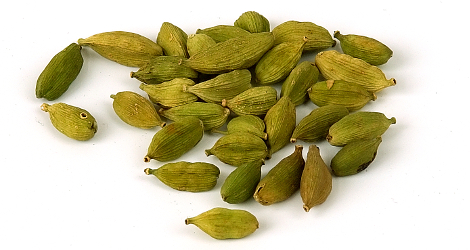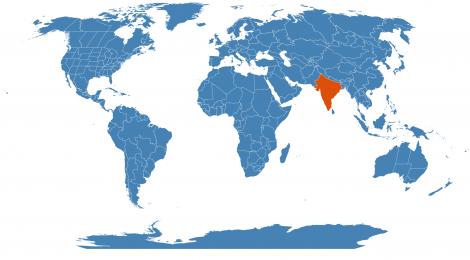Accession Data:
Elettaria cardamomum (L.) Maton
- Common Name: Cardamom
- Family: Zingiberaceae Lindley
- Uses: Cardamon is rich in nutritients such as potassium, iron, fiber, and some magnesium. For centuries, Ayurveda traditions have used the plant to aide in digestive disorders. It is a diuretic that detoxes the body, cleansing infections of both the urinary system and cardiovascular system. Not only is this plant a tonic for the body, essential oil from this plant has resulted in reducing lesions within the intestinal tract.5
It helps with nausea, vomiting, bloated stomach, stomach pain, and intestinal discomfort. This plant aides the Pita veda as a warming agent. This strengthens blood circulation throughout the body and to the lungs. Because of this property, it may help treat respiratory disorders.
Different teas and natural remedies with the plant have been used as effective aides.
Because of the harmful affects of chemically synthesized pesticides, the composition of Cardamom essential oil was tested against three different species of pests. Results showed that Cardamon's antimicrobial properties effectively protected the tree species being treated while killing the pests. 6
- IMPORTANT NOTE: Plant Uses are for informational purposes only. EEB Greenhouses assume no responsibility for adverse effects from the use of any plants referred to on this site. Always seek advice from a professional before using any plant medicinally.
- Culture: Filtered shade, constantly wet roots, ideally temps around 72F, acidic soil.
- USDA Zone: 10a-11
Accession Data:
- Accession # 201500133
- Source: Lynn Janik - UWisc Eau Claire
- Accession Date: 11-12-2015
- Bench: 1202 - AUS:North Bench W
- Currently: active - healthy
- Qty: 2 confirmed on 02-26-2025
Classification:
- Division: Magnoliophyta
- Class: Liliopsida
- SubClass: commelinids
- Order: Zingiberales
- SubOrder:
- Family: Zingiberaceae
- SubFamily: Alpinioideae
- Tribe: Alpinieae
- SubTribe:
Flowering Data:
This accession has been observed in bloom on:| Year | Jan | Feb | Mar | Apr | May | Jun | Jul | Aug | Sep | Oct | Nov | Dec | ||||||||||||||||||||||||||||||||||||||||
|---|---|---|---|---|---|---|---|---|---|---|---|---|---|---|---|---|---|---|---|---|---|---|---|---|---|---|---|---|---|---|---|---|---|---|---|---|---|---|---|---|---|---|---|---|---|---|---|---|---|---|---|---|
| 2025 | ||||||||||||||||||||||||||||||||||||||||||||||||||||
References (internal):
- Spice Plants
- Medicinal Plants
- Medicinal Plants - Ayurveda Medicine
- Medicinal Plants - Urinary System
- Medicinal Plants - Digestive System
- Currently Featured Medicinal Plants
- EEB Greenhouse Holdings native to: India /
References (external):
- The Plant List (2013). Version 1.1. Last accessed on Thursday, February 01, 2018.
- WCSP (2014). World Checklist of Selected Plant Families. Facilitated by the Royal Botanic Gardens, Kew. Last accessed on Thursday, February 01, 2018.
- Elettaria cardamomum at Wikipedia. Last accessed on Thursday, February 01, 2018.
- Image #00 (cropped) & #01 (original) by Luc Viatour [GFDL, CC-BY-SA-3.0 or CC BY-SA 2.5-2.0-1.0], via Wikimedia Commons. Last accessed on Thursday, February 01, 2018.
- A.Jamal, Kalim Javed M. Aslama M.A.Jafri, Gastroprotective effect of cardamom, Elettaria cardamomum Maton. fruits in rats Journal of Ethnopharmacology Volume 103, Issue 2, 16 January 2006, Pages 149-153. Last accessed on Thursday, February 01, 2018.
- Habib Abbasipour, Mohammad Mahmoudvand, Fahimeh Rastegar and Mohammad Hossein Hosseinpour, Fumigant Toxicity and Oviposition Deterrency of the Essential Oil from Cardamom, Elettaria cardamomum, Against Three Stored-product Insects Journal of Insect Science 11(165): 1-10. 2011. Last accessed on Thursday, February 01, 2018.
- Medicinal Plants Names Service at Kew. Last accessed on Wednesday, 22 May, 2019.
data regenerated on Sat, 28 Jun 2025 14:33:09 -0400 [bcm v4.0]
Images:

Additional images for this accession:
Click on thumbnails to enlargeCurrent Accessions in the Zingiberaceae
Subfamily Alpinioideae
Tribe Alpinieae
- Aframomum angustifolium W/C


- Aframomum melegueta W/C


- Aframomum mala

- Alpinia boninsimensis


- Alpinia elegans

- Alpinia galanga W/C


- Alpinia latilabris

- Alpinia maclurei


- Alpinia malaccensis W/C


- Alpinia nigra W/C


- Alpinia kwangsiensis


- Alpinia roxburghii W/C

- Alpinia zerumbet


- Elettaria cardamomum


- Elettariopsis aff. curtisii W/C

- Elettariopsis smithiae W/C


- Elettariopsis sp.
- Etlingera sp. W/C
- Wurfbainia testacea


Subfamily Alpinioideae
Tribe Riedelieae
- Burbidgea schizocheila


- Pleuranthodium schlechteri


- Pleuranthodium schlechteri aff. W/C

- Riedelia sp.
- Siamanthus siliquosus W/C


Subfamily Siphonochiloideae
Tribe Siphonochileae
Subfamily Zingiberoideae
Tribe Globbeae
- Gagnepainia thoreliana


- Globba annamensis


- Globba curtisii W/C


- Globba kerrii W/C


- Globba orixensis W/C


- Globba radicalis W/C


- Globba schomburgkii W/C


- Globba unifolia


- Globba arracanensis W/C


- Globba marantina W/C


- Globba marantina W/C


- Globba pendula W/C


- Globba pendula W/C


- Globba winitii


- Hemiorchis rhodorrhachis W/C


Subfamily Zingiberoideae
Tribe Zingibereae
- Boesenbergia albomaculata W/C


- Boesenbergia kingii W/C


- Boesenbergia longiflora W/C

- Boesenbergia maxwellii W/C

- Boesenbergia pulcherrima W/C


- Boesenbergia rotunda W/C


- Curcuma aeruginosa W/C

- Curcuma aff. elata

- Curcuma attenuata W/C


- Curcuma colorata

- Curcuma heyneana

- Curcuma longa W/C


- Curcuma petiolata W/C


- Curcuma phaeocaulis W/C

- Curcuma rubrobracteata W/C


- Curcuma viridiflora W/C


- Curcuma attenuta aff. W/C
- Curcuma longa


- Curcuma longa


- Curcuma petiolata W/C


- Curcuma singularis W/C


- Distichochlamys rubrostriata W/C


- Haniffia albiflora


- Hedychium forrestii W/C


- Hedychium rubrum

- Hedychium aff. flavescens

- Hedychium coronarium

- Hedychium gardnerianum


- Hedychium greenii
- Hedychium hasseltii

- Hedychium horsfieldii


- Hedychium longicornutum W/C


- Kaempferia gilbertii


- Kaempferia parviflora


- Kaempferia Roscoeana


- Kaempferia sp. Hieroglyphics
- Larsenianthus careyanus


- Rhynchanthus beesianus W/C


- Smithatris myanmarensis W/C


- Stahlianthus involucratus


- Stahlianthus involucratus W/C


- Zingiber corallinum W/C


- Zingiber flavovirens W/C


- Zingiber montanum W/C


- Zingiber rubens W/C


- Zingiber zerumbet

- Zingiber aff. roseum W/C

- Zingiber longiligulatum W/C


- Zingiber montanum W/C


- Zingiber roseum W/C


- Zingiber spectabile

 = indicates flowering in past 14 days
= indicates flowering in past 14 days
 = images available for this accession
= images available for this accession
 = map available for this accession
= map available for this accession
 = accession added within past 90 days
= accession added within past 90 days

